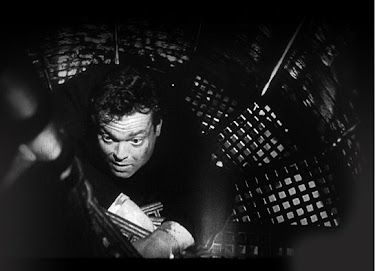Written by: Eric Ambler (novel), Joseph Cotten (screenplay), Richard Collins, Ben Hecht, Orson Welles (uncredited)
Starring: Joseph Cotten, Dolores del Rio, Ruth Warrick, Agnes Moorehead, Jack Durant, Everett Sloane, Orson Welles
Orson Welles graciously denied having any directing role in Norman Foster's Journey into Fear (1943), though his influence appears to be all over it. Citizen Kane (1941) first showcased Welles' fondness for filming people via low and high-angled cameras, a stylistic technique that distorts statures, placing the audience in a position either of power or helplessness. Here, the talented Karl Struss – who also worked on such films as Sunrise: A Song of Two Humans (1927) and Dr. Jekyll and Mr. Hyde (1931) – employs similar techniques, capturing human faces with a threatening immediacy that distorts their features and suggests imminent danger. You won't, of course, fail to notice that the film's cast also boasts more than a few Welles regulars, mostly members of his Mercury Theatre team – Joseph Cotten, Agnes Moorehead, Everett Sloane, Ruth Warrick and Welles himself. The film's screenplay was written by Cotten, his sole attempt at writing {outside some uncredited work on The Magnificent Ambersons (1942)}, a pity since the dialogue is frequently crisp, intelligent and memorable.
 Journey into Fear is one of those rare WWII-themed films of the early 1940s that you wouldn't automatically class as propaganda. Indeed, the Nazis are only mentioned in passing, and the sinister agents who attempt to assassinate Cotten could just as easily be motivated by reasons other than war. Much of the story takes place on a small passenger ship, on which American engineer Howard Graham (Cotten) seeks refuge from German assassins, who are hell-bent on delaying his return home with important Allied intelligence. Silent enemy Peter Banat (played by Welles' agent, Jack Moss) watches ominously from across the ship's cabin, never saying a word, but suggesting sadistic menace through every dryly-amused smirk. Cotten is strong in the lead role, playing Graham as a frightened and confused amateur, a role reminiscent of Holly Martins from The Third Man (1949), rather than the experienced and resourceful American spy we would otherwise expect in such a film. Welles lends his mighty presence to the role of the Turkish Colonel Haki, though he is noticeably more subdued than usual.
Journey into Fear is one of those rare WWII-themed films of the early 1940s that you wouldn't automatically class as propaganda. Indeed, the Nazis are only mentioned in passing, and the sinister agents who attempt to assassinate Cotten could just as easily be motivated by reasons other than war. Much of the story takes place on a small passenger ship, on which American engineer Howard Graham (Cotten) seeks refuge from German assassins, who are hell-bent on delaying his return home with important Allied intelligence. Silent enemy Peter Banat (played by Welles' agent, Jack Moss) watches ominously from across the ship's cabin, never saying a word, but suggesting sadistic menace through every dryly-amused smirk. Cotten is strong in the lead role, playing Graham as a frightened and confused amateur, a role reminiscent of Holly Martins from The Third Man (1949), rather than the experienced and resourceful American spy we would otherwise expect in such a film. Welles lends his mighty presence to the role of the Turkish Colonel Haki, though he is noticeably more subdued than usual.  In one final manner, Journey into Evil is very much like an Orson Welles film: it was re-edited at the studio's request. According to some sources, Welles did some of the trimming himself, recutting the final reel and adding Joseph Cotten's rather awkward narration. At just 68 minutes in length, the film certainly feels as though it has been tampered with. The relationship between Graham and Rosette (Dolores del Rio) is brief and poorly explored, and certainly not worthy of the repeated reassurances that the former frequently bestows upon his anxious wife (Ruth Warrick); there's little indication that their affiliation extended beyond exchanging a few harmless pleasantries. Though the film doesn't exactly feel incomplete – as did a noir like Renoir's The Woman on the Beach (1947) – the bare-bones narrative gives the sense of a minor and inconsequential work. Even so, Journey into Evil is well worth seeking out for its terrific photography – including a superb climax on the slippery ledges of a hotel exterior – and the talents of a very talented cast.
In one final manner, Journey into Evil is very much like an Orson Welles film: it was re-edited at the studio's request. According to some sources, Welles did some of the trimming himself, recutting the final reel and adding Joseph Cotten's rather awkward narration. At just 68 minutes in length, the film certainly feels as though it has been tampered with. The relationship between Graham and Rosette (Dolores del Rio) is brief and poorly explored, and certainly not worthy of the repeated reassurances that the former frequently bestows upon his anxious wife (Ruth Warrick); there's little indication that their affiliation extended beyond exchanging a few harmless pleasantries. Though the film doesn't exactly feel incomplete – as did a noir like Renoir's The Woman on the Beach (1947) – the bare-bones narrative gives the sense of a minor and inconsequential work. Even so, Journey into Evil is well worth seeking out for its terrific photography – including a superb climax on the slippery ledges of a hotel exterior – and the talents of a very talented cast.6.5/10
Currently my #5 film of 1943:
1) Five Graves to Cairo (Billy Wilder)
2) Shadow of a Doubt (Alfred Hitchcock) *
3) Sherlock Holmes Faces Death (Roy William Neill)
4) This Land is Mine (Jean Renoir)
5) Journey into Fear (Norman Foster) *
6) The Seventh Victim (Mark Robson)
7) Hitler’s Children (Edward Dmytryk, Irving Reis)





_poster.jpg)


No comments:
Post a Comment